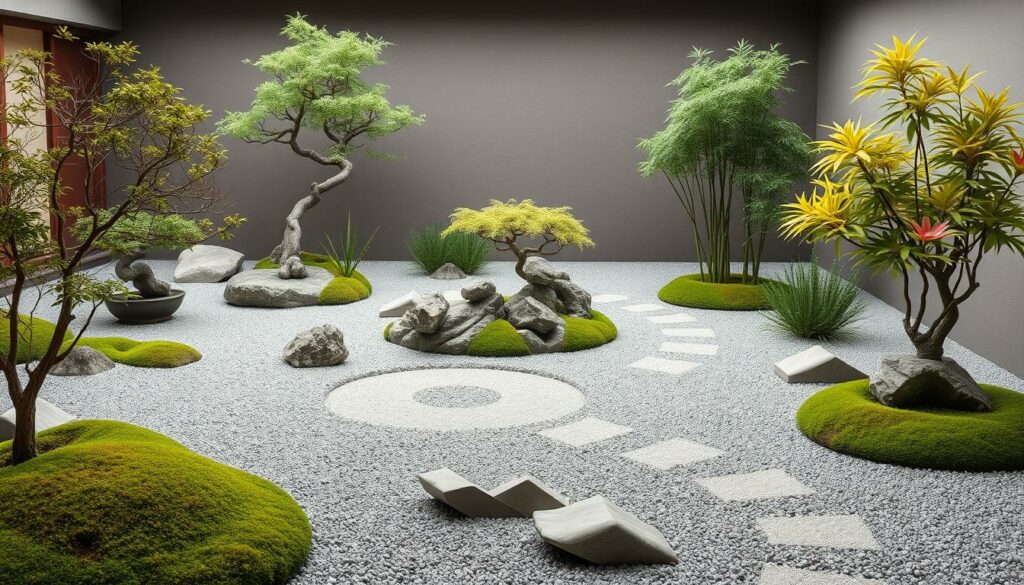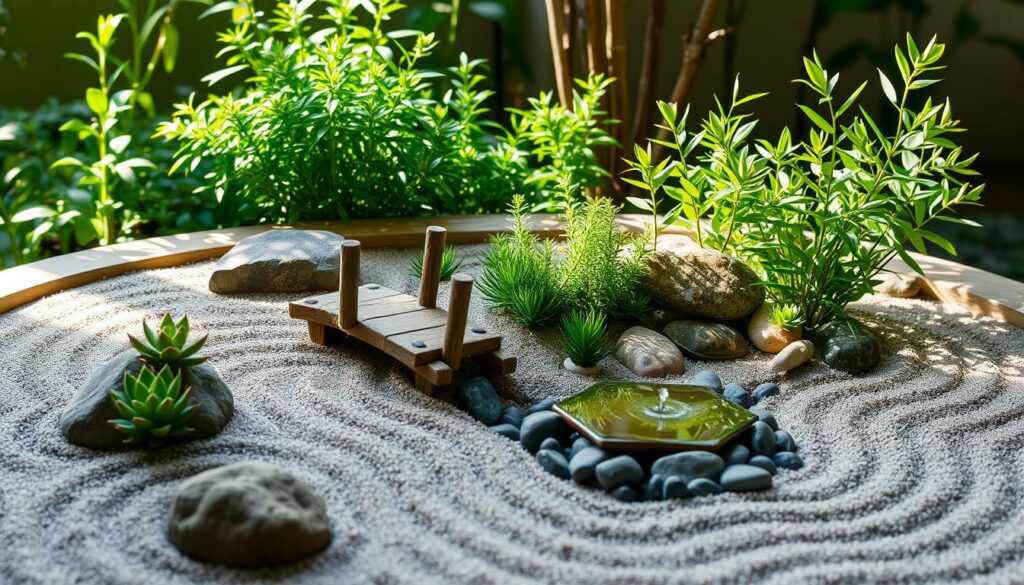Did you know Japanese rock gardens, or Zen gardens, started in the sixth century by Buddhist monks? They were made for meditation. These minimalist spaces use rocks, gravel, and sand to bring peace to outdoor areas. By focusing on simplicity, asymmetry, and naturalness, you can turn your backyard into a calm retreat.
Creating a Zen garden might seem hard, but it’s doable. You can make a beautiful, easy-to-care-for space for meditation, relaxation, or just enjoying nature. This article will show you how to design and maintain your own Zen-inspired backyard.
Key Takeaways
- Zen gardens are minimalist outdoor spaces that use natural elements like rocks, gravel, and sand to promote mindfulness and tranquility.
- Incorporating the principles of simplicity, asymmetry, and naturalness is key to creating an authentic Zen garden design.
- Carefully selecting and arranging the essential elements, such as rocks, gravel, and plants, can transform your backyard into a serene oasis.
- Personalizing your Zen garden with thoughtful decorative features can enhance the overall atmosphere and experience.
- Maintaining a Zen garden through regular raking, pruning, and weeding is important to preserve its tranquil aesthetic.
Zen Garden Design Principles
Zen gardens are designed to bring peace and reflection. They use simplicity, asymmetry, and naturalness. These elements help you escape daily stress and find calm.
Simplicity
Simplicity is key in Zen garden design. They use rocks, gravel, and plants to create balance. This simplicity lets each element stand out, guiding your focus inward.
Asymmetry
Zen gardens reject symmetry for a more natural look. Rocks, paths, and plants are placed in a way that’s not perfect. This makes the garden interesting and encourages exploration.
Naturalness
Zen gardens aim to be like nature. They show the beauty of the wild. Every detail, from gravel to boulders, shows respect for nature.
These principles of simplicity, asymmetry, and naturalness blend to create a peaceful space. A Zen garden in your backyard can be a place for mindfulness and peace.
Choosing a Site for Your Zen Garden
When setting up a zen garden layout in your backyard, where you place it matters a lot. Look for a flat, quiet spot that can be partly or fully closed off. This helps create a sense of being away from the world. Plus, if you can see the garden from inside, you can enjoy its calm all year.
Make sure the ground is level and clear of any junk or blocks. Think about how much sunlight or shade the garden will get. This will help you choose the right plants. Zen gardens often have dry landscapes with a few plants. But, you can also make one where plants are more important.
- Choose a flat, quiet area that can be partially or fully enclosed.
- Position the garden to be visible from inside your home.
- Level the ground and remove any debris or obstacles.
- Consider the orientation to sunlight or shade for plant selection.
“A Zen garden is deeply personal and should reflect the owner’s inner world for peace and introspection.”
By picking the right spot for your backyard design, you can make a peaceful place. The garden’s location is key to setting the mood. It makes your Zen garden a special spot for calm and thought.
Essential Elements of a Zen Garden
To create a peaceful Zen garden, you need to pick the right elements. Rocks, gravel, and sand are at the core, making a calm, meditative space. Adding outdoor decor thoughtfully completes the Zen oasis.
Rocks and Boulders
Large rocks and boulders are the backbone of a Zen garden. They stand for nature’s lasting power. Their weathered look and shapes encourage us to think about the natural world.
Gravel and Sand
The raked gravel or sand is key, showing the flow of water and time. It creates patterns that remind us of water’s movement. Keeping these surfaces neat is crucial for the garden’s calm feel.
Outdoor Decor
Outdoor decor can add to a Zen garden’s beauty. Items like lanterns, Buddha statues, and bridges bring in Japanese flair. But, use them sparingly to keep the peace.
By balancing these elements, you make a space for calm and connection with nature. Your Zen garden, big or small, will be a place for peace and reflection.
Incorporating Plants in a Zen Garden
Traditional Zen gardens often have little greenery. But, adding the right plants can bring seasonal beauty and texture to your garden. Choose low-growing, evergreen plants and Japanese flowers that match the garden’s calm look.
Low-Growing Foliage Plants
Conifers, junipers, and moss are great for a Zen garden. They are low-maintenance and add peace. Sedum, a succulent, also works well in Zen gardens because it loves dry soil.
Japanese Flowering Plants
Japanese maples, azaleas, and cherry trees add color and interest. Their leaves and flowers contrast nicely with the garden’s rocks and gravel. Bamboo and Japanese sedge are also good choices for their calming sounds and looks.
It’s important to pick plants that don’t take over the garden. Instead, they should make the space feel more peaceful and balanced. With the right plants, your Zen garden will be a beautiful and calming place to relax.

“A Zen garden is a living work of art, where every element is carefully chosen to cultivate a sense of tranquility and reflection.”
Small Backyard Zen Garden Ideas
You can make a peaceful small zen garden even with little outdoor space. Place a Zen garden in a corner, by a fence, or against a wall. Use small rocks, gravel, and a focal point like a sculpture or water feature.
Choose dwarf or miniature plants to keep the garden tidy. This way, your urban zen garden stays neat and inviting.
Turn a narrow side yard or alley into a Zen walkway. With smart planning and a simple design, you can make a calm spot in any small backyard. Add bamboo, moss, green plants, lanterns, pathways, and meditation areas for a modern Zen garden.
| Zen Garden Element | Benefits |
|---|---|
| Rocks and Boulders | Symbolize islands or mountains rising from gravel or sand, inviting calmness and tranquility. |
| Raked Sand and Gravel | Mimics waves rippling through water, offering a peaceful and calming appearance. |
| Pruned Trees and Shrubs | Provide symmetry, simplicity, and a connection to nature in the small backyard zen garden. |
| Water Features | The sound of trickling water is a crucial component for spiritual cleansing and relaxation. |
Adding these elements to your small backyard zen garden creates a calm and meditative area. It encourages mindfulness and a connection with nature, even in busy cities.
“Zen gardens promote stress reduction through their minimalist design and tranquil ambiance, encouraging present-moment awareness and fostering mindfulness.”
Creating a Mini Zen Garden
If you don’t have room for a big mini zen garden outside, you can make a small one for indoors. These tiny gardens can bring peace and focus to any room, like your office or home.
Desktop or Indoor Mini Gardens
To make your own tabletop zen garden, start with a small, pretty planter or bowl. Add a low-care plant like a succulent and some sand or gravel. Place a few stones or pebbles to mimic Zen garden features. You can also add a small figurine or rake patterns in the sand for fun.
Traditional mini zen gardens connect us to Japanese culture and design. DIY versions use everyday items to save money. Geometric zen gardens offer a modern look with straight lines and colors. Succulent zen gardens are great for those who want easy-to-care-for plants.
The trend of mini zen gardens shows we want calm and mindfulness in our lives. Portable designs are perfect for relaxation anywhere. Colorful and trendy versions add modern touches like crystals and air plants.

Making a mini zen garden is a mindful activity. As you arrange the elements, focus on your breath and calm your mind. Raking patterns in the sand can be very calming, helping you relax and find peace.
Maintaining Your Zen Garden
Keeping your Zen garden peaceful and visually appealing is key. Caring for your garden is a big part of the Zen way. It helps you stay mindful and connect with nature.
Raking Sand and Gravel
Raking the sand or gravel is a crucial task. It’s a calming activity that keeps your garden looking its best. By raking, you remove debris and restore the garden’s smooth look.
Pruning and Weeding
Pruning and weeding are also important. Trimming plants and removing weeds keeps your garden neat. This care for your garden strengthens your bond with nature.
Spending time on zen garden maintenance keeps your garden beautiful. The actions of raking gravel and garden pruning become calming rituals. They make your backyard a peaceful haven.
Conclusion
Creating a Zen garden in your backyard can turn it into a peaceful oasis. By using simple, asymmetrical, and natural designs, you can make a calm space. Even small areas can be transformed with rocks, gravel, sand, and the right plants.
With some planning and upkeep, your Zen garden will be a place for relaxation. It lets you step away from daily worries and enjoy nature’s beauty. Adding furniture, lights, and art can make it even more welcoming.
By following design tips and choosing the right elements, you can make a Zen garden in your backyard. Plan well, pick the right plants and materials, and care for it. You’ll have a peaceful spot to relax, meditate, and connect with nature.
FAQ
What are the key design principles of a Zen garden?
How do I choose the right site for my Zen garden?
What are the essential elements of a traditional Zen garden?
What types of plants work best in a Zen garden?
How can I create a Zen garden in a small backyard?
Can I create a Zen garden indoors?
How do I maintain the harmony and aesthetics of a Zen garden?
Source Links
1 . how to create a zen garden
2 . How to Make a Zen Garden
3. 13 Zen Garden Ideas: Transforming Your Backyard for Inner Peace
- Growing Bonsai: Tips for Miniature Tree Enthusiasts
- Buying Bonsai: Tips for Selecting Your Perfect Tree
- Bonsai Potting: Essential Tips for Tree Care Success
- Bonsai Maintenance: Essential Care for Tiny Trees
- Mastering the Art of Shaping Bonsai: A Beginner’s Guide


